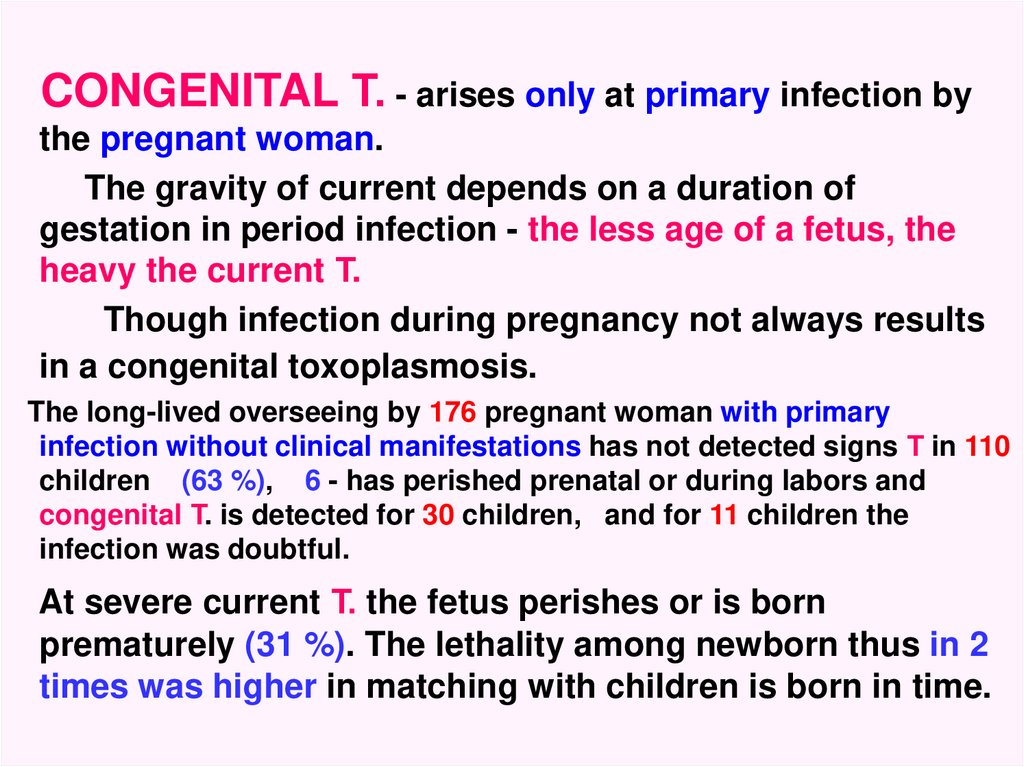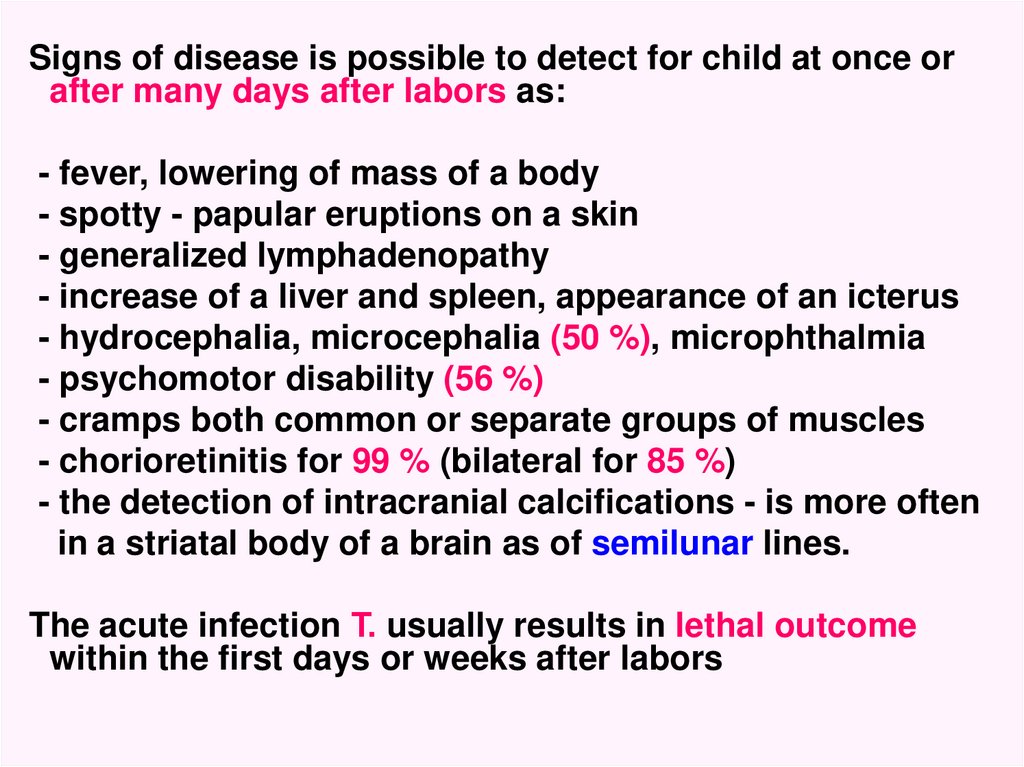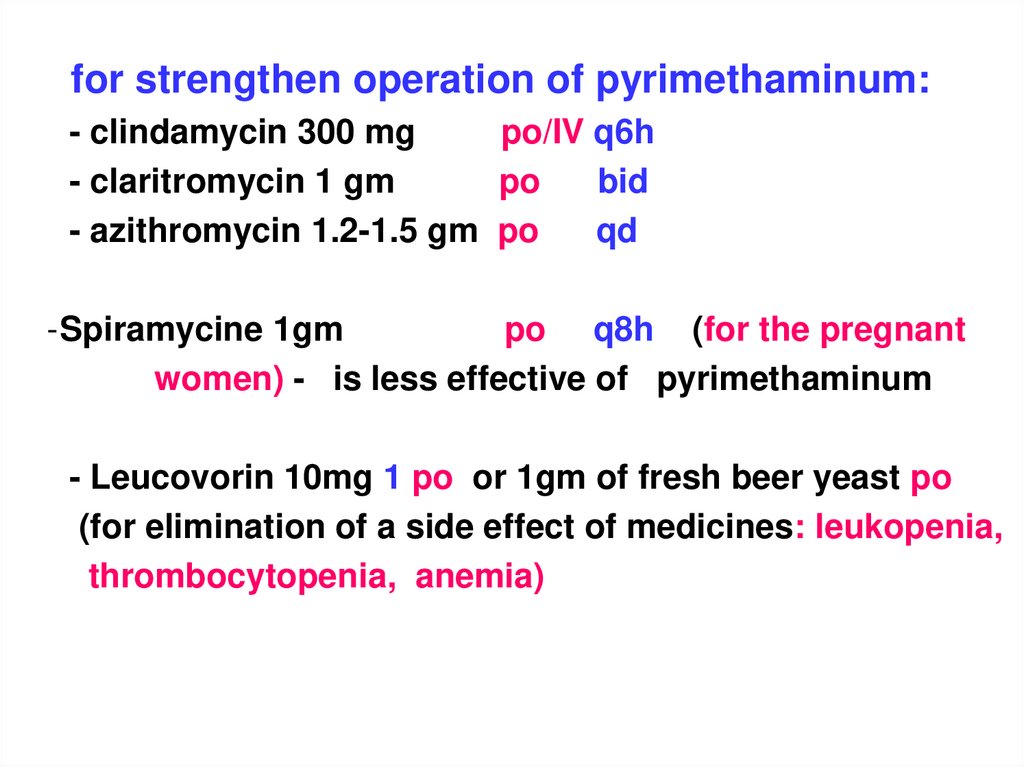Похожие презентации:
Toxoplasmosis (T.) identification
1. TOXOPLASMOSIS ( T.) Identification. Zoonotic disease caused by an оbligate endocellular parasite Toxoplasma gondii,
characteristic by chronic current, lymphadenopathy, increase of a liver and spleen, damageof the nervous system, cross-striated muscles,
myocardium, eyes and often infection of a fetus in
acute period of illness for the pregnant woman
2.
Historic reference.1908 J.Nicolas and L. Manseaux in Tunis detected of the
infectious agent for a local rodent Ctenodactylus gondii.
The infectious agent has received name under of the form
body (toxon - arc, plasma - form)
1914 –Castellani A. detected of the infectious agent in body
the soldier which died on Ceylon, confirmed
pathogenic operation Т. on the man
1823 -Yankee - was described by the first case congenital Т.
1937-1955 гг. А.Sabin and the co-authors - had described
cycle of endocellular reproduction Т. and had
applied Sabin-Feldman dye test to its diagnosis
3.
The actuality of illness is determined by the followingfactors:
- T. infects a large proportion of the world`s population –
from 4% to 68 %
- possibility prenatal of infection of a fetus (at primary
infection during pregnancy)
- absence of legible clinical signs, characteristic only for
the that infection as in acute as chronic stage of disease
- selection its in group AIDS-INDICATOR diseases (1981)
4.
- absence for the doctors of common practice sufficientknowledge and watchfulness concerning that diseasis
- appearance of precise methods of diagnosis permitting to
define a phase of current of the infectious process and to
assign adequate treatment as at acute as the chronic
forms of disease
ETIOLOGY
The infectious agent -Toxoplasma gondii:
- type Apicomplexa,
- class Sporozoa (generator spores),
- group Eucoccidiida ( alternating sexual and asexual cycles
reproduction),
- sort Toxoplasma gondii
5.
It is size from 2- 4 microns of width and to 4 - 7microns of length and remind segment of an orange at a
microscopy.
At a staining on Giemsa cytoplasma gains blue colour,
and core red-violet.
Т. - endocellular parasite having low pathogenic,
therefore infection more often proceeds without clinical
manifestations, coming nearer to “a ideal" parasite from
opportunistic of infections, but at expressed immunodeficiency can cause severe diseases both for animals
and for the man
6.
7.
The biotic cycle Т. consists from sexual and asexualreproduction
The sexual reproduction occurs in an organism
animals of breed felidae (wild and home cats, tigers, lynx
etc.) At their absence - circulation Т. in a nature stops!!
The primary infection of the cats occurs via tissue cysts
(eating rodents or crude meat) or via oocysts (at contact
by the sick cat or with subjects from its of environment)
The envelope cyst or oocyst destroys in a stomach or
intestine of the cats. Sporozoites penetrate into
enterocytes and are transmuted in trophozoites.
8.
Mature trophozoite is divided on merozoites, which partagain penetrate into enterocytes, prolonging an asexual
reproduction (schizogony).
Others - are transmuted into macro- and microgametocytes. The heterosexual gametocytes merge into zygote.
The zygote then become encapsulated within a rigid wall
and are shed as oocyst. The zygote sporulates and
divides to form sporozoites.
During further development the zygote is enlarged up to 10
- 12 microns and is coated with the bilayer envelope.
9.
Oocyst together with feces of the cat gets in the externalenvironment, where within 1- 5 days ripens and is divided
into 2 sporocysts, each of which contains on 4 sporozoites..
The duration of cycle of a reproduction in an organism the
cat occupies 1 - 3 weeks.
The cat can excretes of millions oocysts dayly.
The oocysts in the external environment are saved till 2
years!!!
The oocysts destroy at desiccation, boiling, at effect
concentrated disinfectants.
Derivation of oocysts - ending stage in a body of the main
host Т.
10.
11.
The main intermediate hosts - rats and mice, which sometime can support circulation Toxoplasmae , were engaged a
cannibalism and transmitting Т. to descendants.
Other intermediate hosts ( 300 sorts mammals and 150 sorts
of birds, reptile and man) - are "the dead lock" host
(on definition of epidemiologists)
Cycle of development in an organism of the intermediate
host
From the swallowed oocysts quit sporozoites, which
penetrate into macrophages, is active in them are multiplied
and are spread on lymphatic paths
At destroy a macrophage Т. get in a blood (tachyzoites) also
penetrate into any nuclear cell and initiate with
reproduction
12. A nuclear cell before destroy ( “false cyst”)
13.
After destroy a cell Т. penetrate into other cell recyclingdevelopments. Only at this stage of the parasitemia
develops which allows them through a placenta a fetus!!
The cycle of an asexual reproduction is prolonged before
creation of immunity, that carries on to termination of a
parasitemia and creation tissue cysts in a sceletal muscles,
eyes, brain, cardiac muscle. A size cyst up to 100 microns
with a dense sheath. Т. in its are as bradyzoites.
Derivation tissue cysts - ending stage biotic cycle Т. in a
body of the intermediate host. At this stage the parasitemia
is not observed.
At a stage trophozoites Т. are very unstable and fast perish
at warming up to 50 d.C., at effect 50 % of alcohol and
anyone disinfectants through 5-10 minutes
14.
15.
PATHOMORPHOLOGYThe pathological changes are found out in all bodies both
at congenital and at the acquired toxoplasmosis.
Congenital Т. CNS - is accompanied by damage retinas
and of the choroidinal membranes of the eyes (99 %)
Infectious agents find out as tissue cysts is more often in
muscles.
The inflammation around of them misses or is expressed
unsignificantly.
Tachyzoites in a blood it are found out only at primary
infection.
16.
It is possible to detect granulomas, centers of a necrosisand fibrosis more often in muscles, myocardium, lungs,
liver, spleen, lymphatic nodi.
The sites calcification in a brain find only at congenital as
semilunars in the field of a striatal body.
The lingering character of an infection results in various
allergic manifestations.
The alive Т. can will be saved In cysts all life!
17.
EPIDEMIOLOGY(zoonosis with peroral and vertical mode of infection)
Infection of the man occurs at:
- contact to the cats and subjects enclosing them
- the use it is not enough heat treated or crude meat
- through a placenta (frequency congenital Т. – 1 : 2,700
labors)
- hemotransfusions and the transplantetions of donor
organs
From the man to the man at contact - does not transmit!!!
The proportion infectious of the people coincides with
frequency of infection Т. for animals. More often meets
in the countries a hot and wet climate
18.
CLINIC (incubation interval about 2 weeks)Distinguish 2 forms Т. – congenital and acquired
Acquired Т. - acute, chronic, primary or secondary latent)
Acute acquired Т. – it is generalized infection
- acute beginning, fever, intoxication, pain in muscles
the increase of a liver and spleen (rare) is
- polymorphic exanthema by duration 3 - 4 days
- generalized lymphadenopathy
- encephalitis with form of parasite abscesses ( CT-scan
or MRI
- pneumonia
- myocarditis
- one-sided chorioretinitis (1 %)
19.
20.
21.
To frequency there is a combination of numbered manifestations by an extent of several days or weeksspontaneous convalescence. The frequency of lethal
outcomes is unknown. The exact diagnosis more often is
installed only immunological methods.
Chronic acquired Т. It is long-lived flaccid disease
- subfebrile condition long-lived (months) sometimes with
by periods normal temperature
- chronic intoxication
- damage of many bodies and systems:
- complains: common weakness, lowering of appetite,
dryness in an oral cavity, nausea,
- irritability, disturbance of dream, headache, lowering of
memory,
- pain in heart and palpitation, pain in muscles and joints,
disorder of vision
22.
Objective:- generalized lymphadenopathy
- increase of a liver (50 %) and spleen
- specific myosites with calcifications
- arthralgias
- tachycardia, hypotension, the phenomena of a myocarditis
with focal changes a ECG
- GIT of dull pains in epigastriums, abdominal distention,
constipations, weight loss
- NS - emotional lability, lowering of capacity for work,
irritability, cancerophobia etc.
Sometimes severe neurosises, diencephalic syndrome,
the symptomatic epilepsy (rare) is and for all vegetovascular disorders
23.
- eyes - chorioretinitis (1 %), uveitis, progressing myopia- ES - disorders of menstrual cycle, impotence, secondary
adrenal unsufficiency, the depression of function of
thyroid glands (rare)
- WBC - leukopenia, lymphocytosis, rise eosinocytes at
normal values ESR
The most often form of disease is primary
latent Т:
- is not present and was not in the past of clinic Т.
Diagnosis only by detection of antibodies against Т. the
class Ig G.
Peakings more often only immunological with appearance
IgM
The secondary latent Т. - residual phenomena after
transferred Т. as calcifications, seams after a
chorioretinitis, lowering of vision, scleroses of lymphatic
nodi.
24.
CONGENITAL Т. - arises only at primary infection bythe pregnant woman.
The gravity of current depends on a duration of
gestation in period infection - the less age of a fetus, the
heavy the current Т.
Though infection during pregnancy not always results
in a congenital toxoplasmosis.
The long-lived overseeing by 176 pregnant woman with primary
infection without clinical manifestations has not detected signs Т in 110
children (63 %), 6 - has perished prenatal or during labors and
congenital Т. is detected for 30 children, and for 11 children the
infection was doubtful.
At severe current Т. the fetus perishes or is born
prematurely (31 %). The lethality among newborn thus in 2
times was higher in matching with children is born in time.
25.
Signs of disease is possible to detect for child at once orafter many days after labors as:
- fever, lowering of mass of a body
- spotty - papular eruptions on a skin
- generalized lymphadenopathy
- increase of a liver and spleen, appearance of an icterus
- hydrocephalia, microcephalia (50 %), microphthalmia
- psychomotor disability (56 %)
- cramps both common or separate groups of muscles
- chorioretinitis for 99 % (bilateral for 85 %)
- the detection of intracranial calcifications - is more often
in a striatal body of a brain as of semilunar lines.
The acute infection Т. usually results in lethal outcome
within the first days or weeks after labors
26.
But it can pass in the chronic or secondary - latent formsТ., having left after itself:
- microphthalmia, hydrocephalus
- chorioretinitis, paralyses of eye’s muscles
- psychosomatic or motive disability, cramps.
These children are needed in medical observation and
constant control, as the true damage to health newborn is
possible to estimate more often only after some weeks or
months etc.
27.
DIFFERENTIAL DIAGNOSTICS will be carried out by :- Catscratch disease
- Herpes simplex
- Histoplasmosis
- Listeriosis
- Cytomegalovirus
- HIV-infection, Pneumocytosis
- Infectious mononucleosis,
- Lymphoreticulosis, lymphogranulomatosis,sarcoidosis, Lymphoma
- Sepsis,
- Thyrotoxicosis, chronic tonsillitis etc.
- Rheumatic disease, myocardites,
- Syphilis,
- Mesadenitis
- Hemolytic illness (at congenital Т.),
- Tuberculosis
28.
LABORATORY DIAGNOSIS.1.Microscopy smears CSF ( at congenital Т.) –
xanthochromatic, rise eosinocytes and protein
2. Microscopy smears of a blood, bioptates of lymphatic
nodi, tonsils, placenta, membranes of a fetus, amniotic
fluid (search cysts and Т.)
3. Biological test with the same material with the
subsequent search cysts in sections of tissues animal
4. PCR - CSF, amniotic waters, tissues of the perished fetus,
placenta etc.
5. Immunological methods – ELISA, CFt, IHAt
The IC test with toxoplasmin now will not be used
29.
TREATMENTThe antiparasitic therapy
Will not be carried out:
- at chronic Т. outside of peaking,
- at is primary also secondary - latent Т.
Will be carried out:
- at acute Т.,
- chronic toxoplasmosis with clinical manifestations,
- at a damage of a brain and eyes. using:
- Pyrimethamine 50 - 100 mg 1 po- first day-main drug
then on 25 –50mg 1 po - 29 days
- Sulfadiazine 1-1.5 gm
po q6h
30.
for strengthen operation of pyrimethaminum:- clindamycin 300 mg
po/IV q6h
- claritromycin 1 gm
po
bid
- azithromycin 1.2-1.5 gm po
qd
-Spiramycine 1gm
po q8h (for the pregnant
women) - is less effective of pyrimethaminum
- Leucovorin 10mg 1 po or 1gm of fresh beer yeast po
(for elimination of a side effect of medicines: leukopenia,
thrombocytopenia, anemia)
31.
For the pregnant woman at immunological peaking withoutclinical manifestations - drugs "of the «HEEL" corporation
of Germany now will be used
They have no contraindications and do not render teratogenic of operation under the particular scheme with usage:
Echinacea-composite, Coenzyme - composite, Nozode of a
toxoplasmosis, Lymphomyosote, Galiume or Psorinoheel
etc.
The drugs should be selected by a method of medicamental
testing. The efficiency of treatment makes 93 %
( disappearence of Ig M from of blood of pregnant woman )
Besides the symptomatic and pathogenetic therapy will be
carried out.
32.
PROPHYLAXISThe special attention accesses on group of hazard among
the pregnant woman (absence in plasma of antibodies
against Т.) They should interrupt contacts to the cats, and
also use meat a past valuable heat treatment, carefully
wash hands before eating etc.)
Group of hazard in a population owes revealed among the
girls since 16 years and before pregnancy - valuable
inspection on ТОRCH- of an infection here should be
carried out and during pregnancy to carry out definition of
antibodies only Ig M to the detected earlier infections from
group TORCH (HSH, CMV, ТОХО, rubella)
Woman, which up to pregnancy have antibodies against Т.
– give birth to healthy children.
Other measures because of a wide circulation of a
toxoplasmosis - have small efficiency!!

































 Медицина
Медицина








